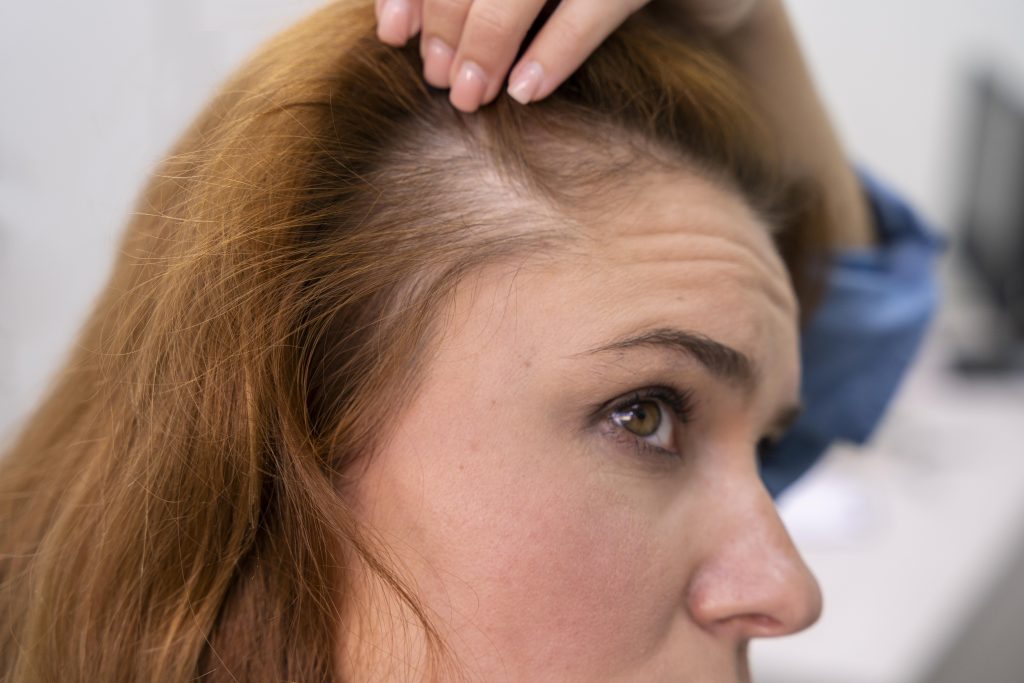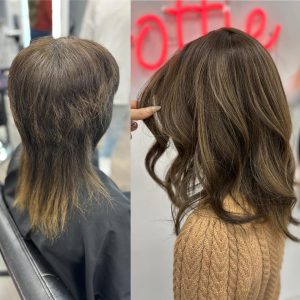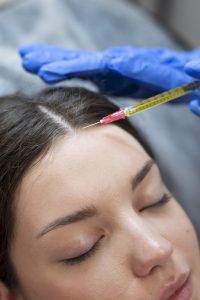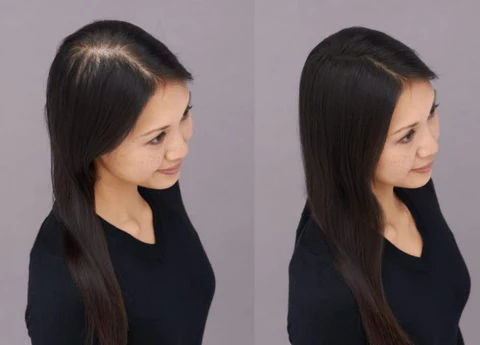1500+ ★★★★★ REVIEWS
Frontal Fibrosing Alopecia (FFA): Understanding the Condition and Exploring Solutions

Frontal Fibrosing Alopecia (FFA) is a progressive hair loss condition that primarily affects women, particularly those post-menopausal, although it can also occur in men. It is classified as a type of scarring alopecia, meaning that it leads to permanent hair loss due to the destruction of hair follicles. This condition is characterized by a receding hairline, often accompanied by redness, scaling, and sometimes itching or burning sensations on the scalp.
Table of Contents
Causes and Symptoms of FFA
The exact cause of FFA remains unknown, but it is believed to be an autoimmune condition where the body’s immune system mistakenly attacks hair follicles, leading to inflammation and scarring. Other contributing factors may include hormonal imbalances, genetic predisposition, and environmental triggers such as exposure to certain skincare products or sunscreens.
Common symptoms of FFA include:
- Progressive receding of the frontal hairline
- Loss of eyebrows
- Redness and inflammation around hair follicles
- Small, raised bumps or papules on the skin
- Itching or burning sensations
Treatment Options for Frontal Fibrosing Alopecia
While there is currently no cure for FFA, various treatments can help slow its progression, manage symptoms, and improve aesthetic appearance. These treatments include medical interventions, topical applications, and non-surgical solutions.
Medical Treatments
- Corticosteroids – Used to reduce inflammation and slow down immune response, either through topical creams, injections, or oral medications.
- 5-Alpha Reductase Inhibitors (e.g., Finasteride, Dutasteride) – These medications help regulate hormonal activity that may contribute to FFA.
- Hydroxychloroquine – An anti-inflammatory drug that has shown some promise in slowing down the progression of FFA.
- Immunosuppressants – Medications such as mycophenolate mofetil can be prescribed to suppress immune system overactivity.
- Tetracyclines – Anti-inflammatory antibiotics that can help reduce scalp redness and irritation.
Topical Treatments
- Minoxidil (Rogaine) – May help in preserving remaining hair and slightly enhancing hair density.
- Tacrolimus or Pimecrolimus – Immunomodulating creams that may reduce inflammation.
- Anti-inflammatory shampoos – Such as those containing ketoconazole or salicylic acid, which help maintain scalp health.
Non-Surgical Solutions
For individuals seeking alternatives to medications or hair transplant surgery, several non-surgical solutions can improve both the appearance and confidence of those with FFA.

1. Mesh Integration System
Mesh integration is an advanced, non-surgical hair replacement technique that provides a natural-looking hair solution for those experiencing hair loss due to FFA. This system involves:
- A breathable mesh being integrated into existing hair using a lightweight, semi-permanent attachment method.
- High-quality human or synthetic hair being woven into the mesh to blend seamlessly with natural hair.
- The system being regularly maintained and adjusted as needed. Mesh integration is an excellent option for those who prefer a non-invasive, semi-permanent hair restoration method without undergoing surgery.
2. Wigs and Hairpieces
Custom-made or ready-to-wear wigs and hairpieces can provide an immediate and effective solution for individuals with FFA. Modern wigs are designed with breathable materials and high-quality fibers to ensure a natural appearance and comfortable wear.
3. Scalp Micropigmentation (SMP)
This is a cosmetic tattooing technique where tiny pigment dots are deposited into the scalp to create the appearance of fuller hair. It works well for individuals who want to camouflage their receding hairline without wearing hairpieces.
4. Platelet-Rich Plasma (PRP) Therapy

PRP therapy involves injecting a concentration of a patient’s own platelets into the scalp to stimulate hair growth and slow hair loss. While not a permanent solution, it can improve hair density and quality when used in combination with other treatments.
5. Hair Fibers and Concealers

Keratin-based hair fibers or scalp concealers can be applied to thinning areas to create the illusion of thicker hair. These products offer a quick and temporary cosmetic fix.
Conclusion
Frontal Fibrosing Alopecia is a distressing condition, but with early intervention and the right treatment approach, individuals can manage symptoms and improve their appearance. While medical treatments aim to slow progression, non-surgical solutions such as mesh integration, wigs, and scalp micropigmentation offer aesthetic alternatives for those seeking to restore confidence without invasive procedures. For those considering mesh integration, Hottie Hair Salon & Extensions Store provides expert solutions tailored to individual needs, ensuring a seamless and natural-looking hair restoration experience. Consulting with a dermatologist or a hair loss specialist can help determine the best course of action based on individual needs and preferences.
FAQ: Frontal Fibrosing Alopecia (FFA) Treatment & Solutions
1. What is Frontal Fibrosing Alopecia (FFA)?
Frontal Fibrosing Alopecia (FFA) is a progressive form of hair loss that primarily affects women, particularly those who are post-menopausal. It leads to permanent hair loss due to the destruction of hair follicles and is often characterized by a receding hairline, scalp redness, itching, and burning sensations.
2. What causes Frontal Fibrosing Alopecia?
The exact cause of FFA remains unknown, but it is thought to be an autoimmune disorder. Hormonal imbalances, genetics, and environmental factors such as certain skincare products or sunscreens may contribute to the condition.
3. What are the common symptoms of FFA?
Symptoms of FFA include:
- Progressive receding hairline
- Eyebrow loss
- Redness or inflammation around hair follicles
- Itching or burning sensations
- Small raised bumps on the skin
4. How can Frontal Fibrosing Alopecia be treated?
While there is no cure for FFA, treatments can help slow the progression and manage symptoms. Medical treatments include corticosteroids, 5-alpha reductase inhibitors, hydroxychloroquine, immunosuppressants, and tetracyclines. Topical treatments like minoxidil, tacrolimus, and anti-inflammatory shampoos can also be beneficial.
5. What non-surgical solutions are available for FFA?
Non-surgical options for FFA include:
- Mesh Integration: A semi-permanent solution involving a breathable mesh and natural hair integration.
- Wigs and Hairpieces: Custom-made or ready-to-wear wigs provide a quick solution to hair loss.
- Scalp Micropigmentation (SMP): A cosmetic tattooing technique that simulates fuller hair.
- Platelet-Rich Plasma (PRP) Therapy: A procedure where the patient’s own platelets are used to stimulate hair growth.
- Hair Fibers and Concealers: Temporary solutions for thicker hair appearance.
6. What is mesh integration, and how does it help with FFA?
Mesh integration is a non-surgical hair restoration technique used to help individuals with conditions like FFA (Frontal Fibrosing Alopecia), a type of scarring alopecia that causes hair loss along the hairline and brows. This method involves attaching a fine mesh material to the scalp, which acts as a base for integrating hair extensions or wigs. The mesh helps create a seamless, natural-looking result by providing coverage and volume while allowing the scalp to breathe. Mesh integration can help those with FFA manage their hair loss by enhancing their hair’s appearance without causing further damage to the sensitive scalp, offering a comfortable and effective solution to achieve fuller hair.
7. How effective is PRP therapy for FFA?
PRP (Platelet-Rich Plasma) therapy can be an effective treatment for FFA (Frontal Fibrosing Alopecia), though results may vary depending on the severity and progression of the condition. PRP therapy involves drawing a small amount of the patient’s blood, processing it to concentrate the platelets, and then injecting it into the scalp. The growth factors in PRP are thought to stimulate hair follicles, promote regrowth, and reduce inflammation. For FFA, PRP may help slow the progression of hair loss and potentially promote new hair growth in the affected areas. While many patients see positive results, such as improved hair density and reduced shedding, PRP is not a guaranteed cure and may need to be combined with other treatments for optimal results. Consulting with a specialist is essential to determine if PRP is a suitable option for managing FFA.
8. Can I wear wigs or hairpieces to cover FFA?
Yes, wearing wigs or hairpieces is an excellent option for covering hair loss caused by FFA (Frontal Fibrosing Alopecia). Since FFA can lead to significant thinning or hair loss along the hairline and other areas of the scalp, wigs and hairpieces offer a seamless and natural-looking solution to restore volume and confidence. High-quality wigs and hairpieces, like those available at Hottie Hair Salon & Extensions Store, come in various styles, colors, and lengths to suit individual preferences. They can be customized to match your natural hair and ensure comfort while protecting the sensitive scalp from further irritation. With the right fit and styling, wigs and hairpieces provide a versatile, non-medical solution to manage the appearance of FFA.
9. What should I do if I suspect I have FFA?
If you suspect you have FFA (Frontal Fibrosing Alopecia), it’s important to consult a dermatologist or a healthcare professional who specializes in hair loss. They can evaluate your symptoms, conduct a thorough examination, and may perform a scalp biopsy to confirm the diagnosis. Early detection is key to managing FFA, as treatments can help slow its progression and reduce the risk of permanent hair loss. Your doctor may recommend topical treatments, oral medications, or therapies such as corticosteroids to manage inflammation and promote hair retention. Additionally, they can offer guidance on lifestyle changes, hair care practices, and non-medical options like wigs or hairpieces if necessary. Prompt action and professional advice can help you address FFA effectively.
10. Where can I get mesh integration treatment for FFA?
If you’re looking for mesh integration treatment for FFA (Frontal Fibrosing Alopecia), Hottie Hair Salon & Extensions Store offers expert services to help restore your hair’s appearance. Their mesh integration technique provides a natural, seamless solution, carefully tailored to your specific needs and preferences. By attaching a fine mesh to the scalp and integrating high-quality hair extensions or pieces, Hottie Hair helps you achieve a fuller, more voluminous look while maintaining comfort and a natural feel. Their professional team ensures that the integration process is done with precision, offering you a non-invasive and effective way to manage hair loss caused by FFA.
You must be logged in to post a comment.